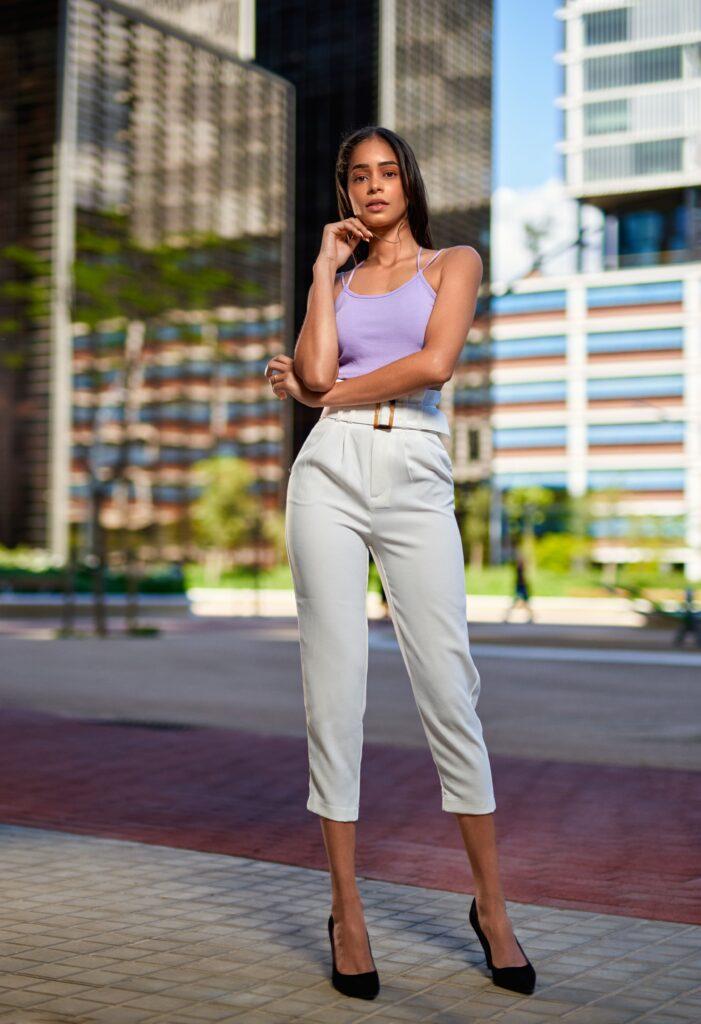Have you ever wondered why don’t women’s clothes have pockets? OR some will say why do women clothes often lack functional pockets? It’s a perplexing issue that has left many women frustrated and inconvenienced.
While men’s trousers and pants are typically equipped with spacious pockets, women often have to rely on bags, handbags, or pouches to carry their essentials.
This long-standing problem in some cases in women’s apparel which raises the question: why don’t most women’s clothes have pockets? Additionally, historical garments like corsets have further limited pocket options for women.
Join us as we uncover the history, challenges, and implications surrounding the absence of pockets in women’s apparel, man, clothing function.
Historical and Cultural Factors: Understanding the Lack of Pockets in Women’s Apparel
A History of Baggage
Throughout history, women have carried their personal belongings using bags or purses rather than pockets. This practice can be traced back to the 17th century when pockets were initially introduced in men’s clothing. While men enjoyed the convenience of pockets, women were left with no such luxury.
Fashion Over Function
One of the main reasons why women’s clothes lack pockets is that fashion trends throughout history prioritized aesthetics over practicality for women.
In the 1800s, as silhouettes became more streamlined and form-fitting, adding bulky pockets would disrupt the desired look.
Designers focused on accentuating curves and creating sleek lines, leaving no room for functional storage.
Cultural Norms at Play
Cultural norms also played a significant role in limiting the inclusion of pockets in women’s garments. In societies where women were expected to be dependent on men, having a lot of places to carry personal items was not seen as necessary.
Instead, it was considered more appropriate for women to rely on others or carry small accessories like purses.
The French Revolution Effect
The French Revolution in the late 18th century had a profound impact on fashion and pocket availability for both men and women. During this time, there was a shift towards equality and practicality in clothing design.
However, while men’s clothing began incorporating more functional pockets, women’s fashion continued to prioritize style over utility.
The Victoria & Albert Museum Collection
To get a glimpse into this historical phenomenon, one can explore collections at prestigious institutions like the Victoria & Albert Museum in London.
Here you will find an array of exquisite dresses from different eras that exemplify how pocketless designs prevailed due to societal expectations, prevailing fashion trends, and the prevalence of tiny pockets.
Gender Norms and Societal Expectations: Influences on Women’s Fashion Design
Traditional gender roles have influenced the design of women’s clothing, emphasizing femininity over functionality.
One cannot help but notice the lack of pockets in many garments. This absence of functional storage space can be attributed to the influence of traditional gender roles on fashion design.
Throughout history, women have been expected to prioritize their appearance and adhere to societal expectations of femininity. As a result, functionality has often taken a backseat.
In the fashion industry, there is a long-standing belief that women should look elegant and graceful at all times.
This emphasis on aesthetics has led designers to prioritize form-fitting silhouettes and sleek lines. Unfortunately, incorporating pockets into such designs can disrupt the desired visual flow or add bulkiness where it is not deemed desirable. Consequently, many women’s garments are designed without pockets altogether.
Societal expectations regarding appearance and silhouette have affected pocket placement and size in women’s apparel.
Society plays a significant role in shaping fashion trends and preferences, including the design and tailoring of clothes.
The hourglass figure, emphasizing a small waistline and curvaceous hips, has long been considered the epitome of feminine beauty, influencing how garments are designed to hug the body closely. Additionally, designers may incorporate tiny pockets for added functionality and style.
Unfortunately, this focus on creating visually appealing silhouettes leaves little room for practicality like pockets. Placing pockets in strategic locations can disrupt the desired smooth lines or create unflattering bulges in certain areas.
As a result, pockets are often sacrificed in favor of maintaining an aesthetically pleasing appearance.
Stereotypes surrounding femininity have contributed to the exclusion of pockets from many women’s garments.
Throughout history, society has perpetuated stereotypes about femininity, associating it with fragility, delicacy, and the need for constant assistance.
These stereotypes have seeped into the fashion industry, influencing designers to create clothes that align with these societal expectations.
By excluding pockets from women’s clothing, designers inadvertently reinforce the notion that women are reliant on others for carrying their belongings.
This exclusion of pockets sends a message that women should not be burdened with practicality or self-sufficiency.
Instead, they are encouraged to rely on handbags or purses as accessories that complement their outfits. While these accessories can undoubtedly enhance a woman’s look, they also perpetuate the idea that women’s clothing should prioritize style over functionality.
Fashion vs. Functionality: Debunking the Myth that Pockets Ruin Women’s Fashion
Pockets Are Not Fashion Foes
Contrary to popular belief, the idea that pockets ruin the look of women’s clothing is nothing more than a perpetuated myth. This notion not only limits women’s choices but also reinforces gender stereotypes.
The truth is, many fashion designers have successfully incorporated functional pockets into stylish designs for women, proving that fashion and functionality can coexist harmoniously.
Embracing Versatility
Balancing fashion with functionality can enhance the overall appeal and versatility of women’s attire. By including pockets in their designs, fashion brands empower women to carry their essentials conveniently and confidently without relying solely on purses or bags.
Pockets provide an added layer of convenience, allowing women to keep their belongings close at hand while maintaining a chic appearance.
Breaking Free from Stereotypes
The belief that pockets are unsuitable for women’s clothing stems from outdated gender norms that dictate women should rely on purses as accessories.
However, it’s time to break free from these stereotypes and embrace the practicality of pockets. After all, why should men have all the convenience? Women deserve fashionable options that offer both style and utility.
Designers Leading the Way
Numerous fashion designers have recognized the demand for functional pockets in women’s clothing and have risen to meet this need with innovative designs.
These designers understand that incorporating pockets doesn’t mean compromising on style; instead, it adds an element of practicality without sacrificing aesthetics.
Here are some notable examples:
- Stella McCartney: Known for her commitment to sustainability, McCartney has created elegant dresses with hidden side pockets, offering a seamless blend of style and utility.
- Rebecca Minkoff: This designer embraces functionality by incorporating spacious front or back pockets into her handbags and crossbody styles.
- Eileen Fisher: Recognizing the importance of comfort and convenience, Fisher includes pockets in her dresses and pants, allowing women to go about their day with ease.
Embracing the Pocket Revolution
The pocket revolution is gaining momentum as more fashion-forward individuals demand functional pockets in their clothing. With this shift in consumer preferences, designers are increasingly incorporating pockets into a wide range of garments, including skirts, dresses, and even formal attire.
By embracing the pocket revolution, women can enjoy the freedom of leaving their purses at home while still having a place to store essentials like keys, phones, or lipstick. Pockets offer practicality without compromising style or femininity.
The Impact of Limited Storage: Exploring the Practicality Issues Faced by Women
Carrying Essentials Becomes Cumbersome
For many women, the lack of adequate storage options in their clothing can make carrying essentials a cumbersome task.
Without pockets or other convenient storage solutions, females often find themselves struggling to keep their belongings close at hand. Imagine constantly having to rummage through a purse or bag just to find your phone or keys. It’s not only time-consuming but also frustrating.
Daily Activities Affected
The limited storage options in women’s clothing have a significant impact on daily activities. One of the most common challenges is phone accessibility.
With no pockets to slip their mobile phones into, women often resort to carrying them in their hands or placing them inside bags where they are easily misplaced or forgotten.
Carrying keys is another issue faced by women due to the lack of pockets. Many females end up having to hold onto their keys throughout the day, which can be inconvenient and uncomfortable. Small items like lip balm or tissues have nowhere convenient to be stored, leading to the constant need for a bag or purse.
Hindrance to Productivity and Convenience
The practicality issues caused by limited storage options can hinder productivity and convenience for busy modern-day women. For instance, imagine being in a rush and needing quick access to your phone while juggling multiple tasks.
Without pockets, you may have to put down what you’re doing just to retrieve your device from your bag or purse.
Moreover, having easy access to essential items becomes even more crucial. Women without pockets may feel more vulnerable as they struggle with keeping track of their belongings amidst the hustle and bustle.
Seeking Solutions
Given these challenges faced by women due to limited storage options in their clothing, it’s important for designers and manufacturers alike to address this issue proactively. By incorporating practical storage solutions, they can enhance the functionality of women’s clothing and cater to their needs.
Some possible solutions include:
- Introducing pockets in dresses, skirts, and other traditionally pocket-less garments.
- Creating stylish accessories that provide additional storage options without compromising fashion.
- Designing clothing with hidden or discreet pockets that blend seamlessly into the garment’s aesthetic.
By embracing these solutions, designers can empower women to carry their essentials conveniently while maintaining their personal style.
Breaking Stereotypes: The Need for More Functional Clothing Options for Women
Challenging Traditional Gender Norms
In today’s world, challenging traditional gender norms has become a crucial aspect of promoting equality and empowerment.
While progress has been made in various areas, one aspect that often goes unnoticed is the lack of functional clothing options for women.
It’s time to break free from restrictive stereotypes and offer women garments that prioritize functionality, including the inclusion of pockets.
Women Deserve Garments That Cater to Their Needs
It’s no secret that women have diverse needs. Yet, many fashion brands continue to produce garments that prioritize style over functionality.
This discrimination against women’s clothing is not only frustrating but also perpetuates outdated gender roles. By neglecting to include pockets in women’s clothes, brands are sending a message that women should rely on handbags or other accessories to carry their belongings.
Imagine the convenience if women had pockets in their clothes! They could easily carry their keys, phones, wallets, and other essentials without having to rely on external accessories.
Pockets would provide practicality and freedom of movement, allowing women to go about their day without constantly worrying about where they can store their belongings.
Embracing Functional Fashion Empowers Women
By embracing functional fashion and offering more clothing options with pockets for women, we can empower them to be self-reliant and independent. It’s time to challenge the notion that women need assistance or extra accessories just because they don’t have pockets in their clothes. Providing functional clothing options will enable them to navigate through daily life with ease and confidence.
Moreover, breaking away from the stereotype that pockets are a masculine feature will help redefine societal expectations around gender roles.
Men have enjoyed the convenience of pockets in their clothes for centuries; it’s high time we level the playing field by offering similar options for women.
The Need for Change
The need for change is evident. Women should not have to compromise on functionality for the sake of fashion. Here are a few examples of how pockets in women’s clothes can make a significant difference:
- Carrying personal belongings: Women often struggle to find a safe and convenient place to carry their essentials. With pockets, they can keep their phones, keys, and wallets close at hand.
- Going hands-free: Pockets allow women to go about their day without constantly needing to hold onto a bag or purse. This frees up their hands for other tasks or simply provides more comfort.
- Equalizing storage options: Why should men have all the convenience? Including pockets in women’s clothes would ensure equal opportunities for carrying items.
It’s time for clothing brands to step up and provide functional clothing options that cater to the needs of women. By doing so, we can break free from restrictive stereotypes and empower women with garments that prioritize both style and functionality.
So let’s challenge the status quo and demand change! It’s time to embrace functional fashion and give women the freedom they deserve. Let’s make sure that no woman is left without pockets!
Inclusion of Pockets: Addressing the Demand for Practicality in Women’s Apparel
Functional Fashion: Meeting the Needs of Modern Women
In recent years, there has been a growing demand for functional clothing that caters to the practical needs of women. Gone are the days when fashion was solely focused on aesthetics.
Today, women want garments that not only look good but also serve a purpose. One crucial aspect that has caught the attention of designers and retailers is the inclusion of pockets in women’s clothing.
Responding to Consumer Demands
Designers and retailers have started to recognize the importance of providing practical options for women. Many brands have taken note of consumer feedback and advocacy, leading them to incorporate functional pockets into their designs.
No longer confined to tiny pockets or relying solely on handbags, purses, or pouches, modern women can now enjoy the convenience and versatility offered by well-placed pockets.
Embracing Slimmer Silhouettes
The inclusion of pockets in women’s apparel has also contributed to the rise of slimmer silhouettes. Traditionally, skirts were devoid of any pocket space, leaving women with limited options for carrying their essentials.
However, with innovative design techniques and an emphasis on functionality, skirts now feature discreetly integrated pockets that blend seamlessly with their sleek profiles.
Redefining Handbag Dependency
For decades, handbags have been an essential accessory for women who needed a place to store their belongings. However, as fashion evolves to meet practical demands, handbag dependency is being redefined.
With functional pockets becoming more prevalent in various garments such as dresses and pants, women no longer need to rely solely on handbags for storage.
A Return to Sewing Skills
The resurgence of pocketed garments has also led many individuals to revisit sewing skills once thought obsolete.
As some brands continue to lag behind in providing ample pocket space for women’s clothing items, sewing enthusiasts have taken matters into their own hands.
With a petticoat here or a cleverly sewn pocket there, these skilled individuals are ensuring that women can enjoy the convenience of pockets in any garment they desire.
Reflecting on the Importance of Balancing Fashion and Functionality in Women’s Clothing
In conclusion, the lack of pockets in women’s clothing can be attributed to a combination of historical and cultural factors, gender norms and societal expectations, as well as the ongoing debate between fashion and functionality.
The impact of limited storage options poses practicality issues for women, highlighting the need for more functional clothing choices.
Historically, women’s apparel has been designed with a focus on aesthetics rather than utility. This can be traced back to traditional gender roles where women were expected to carry smaller personal belongings or rely on bags and purses.
Such practices have become ingrained in our culture, perpetuating the absence of pockets in women’s garments.
Gender norms and societal expectations also play a significant role in shaping women’s fashion design. Society often associates femininity with delicate silhouettes that prioritize form over function.
As a result, designers tend to prioritize creating sleek and streamlined designs that may sacrifice practicality.
However, it is important to debunk the myth that pockets ruin women’s fashion. Many designers have successfully incorporated pockets into their collections without compromising style.
By finding innovative ways to blend fashion and functionality, such as discreetly integrating pockets or utilizing fabric manipulation techniques, it is possible to create garments that are both fashionable and practical.
The limited storage options faced by women can be inconvenient and impractical in daily life scenarios. Carrying a bag at all times is not always feasible or desirable for every occasion. Having accessible pockets allows for greater convenience, providing a safe space to store essential items like keys, phones, or wallets without relying solely on external accessories.
To address this issue effectively, there is a growing demand for more functional clothing options for women. By including pockets as a standard feature across various garment types such as dresses, skirts, and pantsuits, brands can cater to the needs of modern-day consumers who seek both style and practicality.
In conclusion, the lack of pockets in women’s clothing is a complex issue influenced by historical, cultural, and societal factors. It is essential to challenge traditional norms and embrace more inclusive designs that prioritize both fashion and functionality.
By acknowledging the demand for practicality and incorporating pockets into women’s apparel, we can empower individuals to navigate their daily lives with ease while expressing their personal style.
FAQs: Why Don’t Women’s Clothes Have Pockets
Q: Are there any brands that offer women’s clothing with functional pockets?
A: Yes, several brands have recognized the need for functional pockets in women’s clothing. Companies like Everlane, Eileen Fisher, and Beta brand are known for incorporating practical pockets into their garments.
Q: Do pockets affect the overall aesthetics of women’s clothing?
A: No, pockets do not necessarily compromise the aesthetics of women’s clothing. Designers have proven that it is possible to seamlessly integrate pockets into garments without sacrificing style or silhouette.
Q: Why do some designers still exclude pockets from their women’s clothing designs?
A: Some designers may still exclude pockets due to adherence to traditional gender norms or a belief that sleek silhouettes take precedence over functionality. However, there is an increasing movement within the fashion industry to challenge these conventions.
Q: Can adding pockets increase the cost of women’s clothing?
A: While adding functional pockets may slightly increase production costs, it does not necessarily lead to a significant price hike in women’s clothing. The inclusion of well-designed and properly integrated pockets should be considered a standard feature rather than an additional luxury.
Q: How can I advocate for more pocket-inclusive options in women’s fashion?
A: As a consumer, you can make your voice heard by supporting brands that prioritize functionality and providing feedback directly to designers or through social media platforms. By showing demand for pocket-inclusive options, you contribute to driving change within the industry.













